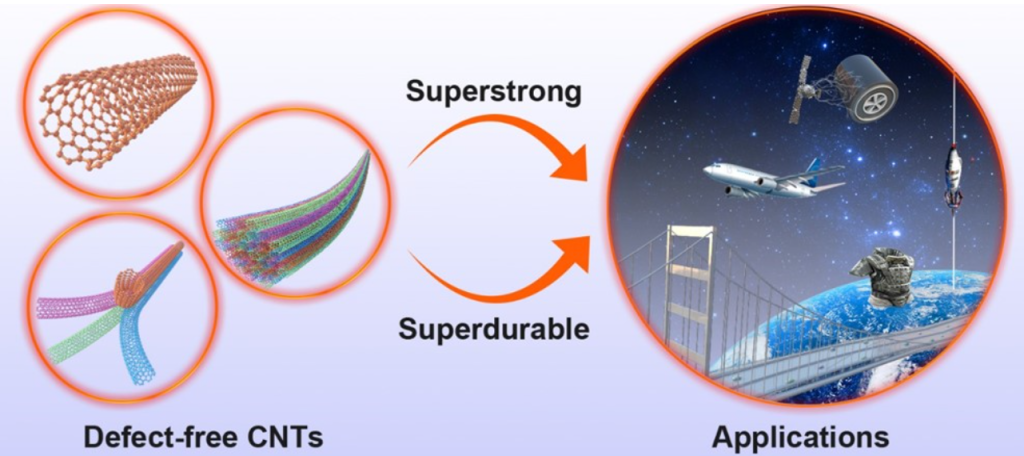in Spacecraft: Lightweight Design and High-Strength Applications
The continuous advancement of space exploration necessitates the development of innovative materials capable of meeting the demanding requirements of the aerospace industry. Among these materials, carbon nanotubes (CNTs) have emerged as a revolutionary solution. Due to their exceptional mechanical, electrical, and thermal properties, CNTs offer unprecedented potential for lightweight design and high-strength applications in spacecraft. This article explores the role of CNTs in spacecraft, detailing their contributions to weight reduction, structural reinforcement, thermal management, and more.

The Need for Lightweight and High-Strength Materials in Spacecraft
Spacecraft are subjected to extreme conditions, including intense vibrations during launch, microgravity in space, and exposure to radiation and temperature fluctuations. The choice of materials is critical to ensure the durability, functionality, and efficiency of spacecraft. Lightweight and high-strength materials not only enhance performance but also reduce launch costs, as every kilogram added to a payload significantly increases expenses. Traditional materials, such as aluminum alloys and titanium, have served the aerospace industry well, but they face limitations in meeting the growing demand for higher performance and reduced weight. CNTs offer a game-changing alternative.
Overview of Carbon Nanotubes
Carbon nanotubes are cylindrical structures made of carbon atoms arranged in a hexagonal lattice. Depending on their configuration, CNTs can be classified into single-walled carbon nanotubes (SWCNTs) or multi-walled carbon nanotubes (MWCNTs). Their unique structure gives CNTs exceptional properties, including:
- High Strength-to-Weight Ratio: CNTs exhibit tensile strengths up to 100 GPa, making them 100 times stronger than steel at a fraction of the weight.
- Superior Thermal Conductivity: With a thermal conductivity of 3000-5000 W/m·K, CNTs effectively dissipate heat.
- Electrical Conductivity: CNTs can conduct electricity with minimal resistance, rivaling metals like copper.
- Flexibility and Resilience: Despite their strength, CNTs are highly flexible and capable of withstanding deformation without permanent damage.
Applications of CNTs in Lightweight Spacecraft Design
1. Structural Components
The integration of CNTs into composite materials allows for the creation of ultra-light and strong structural components, such as:
- Satellite Frames and Panels: CNT-reinforced composites reduce the weight of satellite structures without compromising durability.
- Payload Supports: CNT-based materials provide enhanced load-bearing capabilities for instruments and sensors.
By replacing traditional materials with CNT composites, spacecraft manufacturers can achieve significant weight savings, enabling the inclusion of additional payloads or reducing launch costs.
2. Radiation Shielding
Spacecraft are exposed to cosmic radiation and solar particles, which can damage electronic systems and pose risks to astronauts. CNTs offer a lightweight solution for radiation shielding. Functionalized CNTs can be incorporated into polymer matrices to create radiation-resistant coatings and layers. These materials provide effective shielding while maintaining structural integrity.
3. Fuel Tanks and Propellant Storage
Fuel tanks and propellant storage systems must withstand high pressures and extreme temperature changes. CNT composites’ exceptional strength and resistance to thermal stress make them ideal for these applications. Lightweight CNT-reinforced tanks reduce the overall mass of the spacecraft, improving fuel efficiency and mission range.
CNTs for High-Strength Applications in Spacecraft
1. Launch Vehicle Components
During launch, spacecraft experience extreme vibrations and forces. CNT-based materials are ideal for components like fairings, nozzles, and interstage structures, where both strength and weight reduction are critical. Their ability to absorb and dissipate energy helps mitigate the effects of launch-induced stress.
2. Reinforcement of Solar Panels
Solar panels are essential for spacecraft power generation but are prone to damage from micrometeoroids and mechanical stresses. CNTs enhance the mechanical strength of solar panels, making them more resilient while maintaining their lightweight nature. Additionally, CNTs’ excellent electrical conductivity improves the efficiency of energy transmission within the panels.
3. Space Debris Protection
Space debris poses a significant threat to spacecraft. CNTs can be integrated into shielding systems to create lightweight, high-strength barriers. For example, CNT-reinforced fabrics can absorb and dissipate the energy from debris impacts, protecting critical components.
Thermal Management in Spacecraft
Effective thermal management is vital for maintaining the functionality of spacecraft systems. CNTs excel in this domain due to their superior thermal conductivity. Applications include:
- Heat Dissipation: CNTs are used in thermal interface materials (TIMs) to facilitate heat transfer between electronic components and radiators.
- Thermal Coatings: CNT-based coatings regulate the temperature of spacecraft surfaces by dissipating heat efficiently.
- Cryogenic Systems: CNT composites’ ability to perform under extreme cold makes them suitable for cryogenic fuel storage and insulation.
Challenges and Future Prospects
Despite their potential, several challenges hinder the widespread adoption of CNTs in spacecraft:
- Cost: The production of high-quality CNTs remains expensive, limiting their accessibility.
- Scalability: Manufacturing large quantities of CNT-based composites with consistent properties is challenging.
- Dispersion: Achieving uniform dispersion of CNTs in matrices is critical to realizing their full potential.
Ongoing research aims to address these challenges. Advances in production methods, such as chemical vapor deposition (CVD) and functionalization techniques, are expected to lower costs and improve scalability. Furthermore, the integration of CNTs with other nanomaterials, such as graphene, opens new possibilities for hybrid materials with enhanced performance.
Case Studies and Real-World Applications
1. NASA’s Exploration Efforts
NASA has explored the use of CNT-reinforced composites for various spacecraft components. For example, CNT-based materials are being tested for lightweight structural elements in deep-space exploration missions.
2. CubeSats
Small satellites, such as CubeSats, benefit significantly from CNT technology. The weight reduction achieved through CNT composites allows for more compact designs, enabling multiple CubeSats to be launched simultaneously.
3. SpaceX and Private Sector Innovations
Private companies like SpaceX are also investing in CNT research to develop reusable launch vehicles and lightweight spacecraft components.
Conclusion
Carbon nanotubes represent a transformative material for the aerospace industry, offering unparalleled advantages in lightweight design and high-strength applications. From structural components to thermal management systems, CNTs enable spacecraft to achieve higher performance and efficiency while reducing costs. As challenges in production and scalability are addressed, CNTs are poised to become a cornerstone of next-generation spacecraft design, paving the way for more ambitious and sustainable space exploration endeavors.

